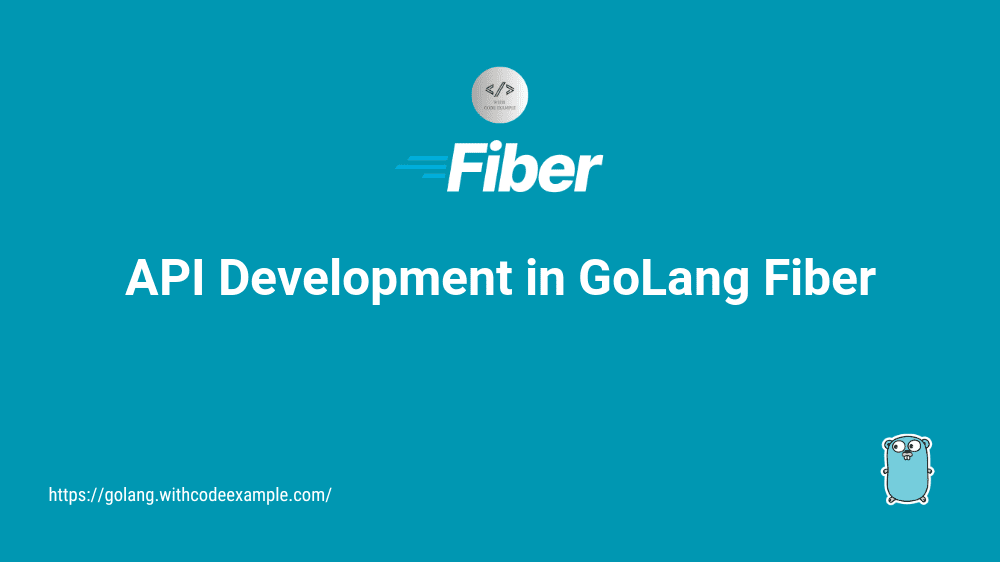API Development with GoLang Fiber
- With Code Example
- November 15, 2023
Building Scalable and Interactive RESTful APIs
Series - Fiber Golang
- 1: Introduction to GoLang Fiber
- 2: Routing and Middleware in Fiber Golang
- 3: Request and Response Handling in Fiber
- 4: Templates and Views in Fiber Golang
- 5: Database Integration in GoLang Fiber
- 6: Secure Authentication and Authorization in GoLang Fiber
- 7: File Upload and Handling in GoLang Fiber
- 8: API Development with GoLang Fiber
- 9: Testing and Debugging in GoLang Fiber
- 10: Deployment and Scaling of GoLang Fiber Applications
In the dynamic world of web development, creating robust and efficient APIs is fundamental to building scalable and interactive applications. GoLang Fiber , a high-performance web framework, offers a seamless environment for API development. In this comprehensive guide, we’ll explore the intricacies of building RESTful APIs with Fiber, handling API routes and requests, serializing and deserializing data using JSON, incorporating versioning and API documentation, and implementing features like rate limiting and request validation. By the end of this guide, you’ll be well-equipped to embark on your journey of crafting powerful APIs with GoLang Fiber.

Building RESTful APIs with Fiber
Representational State Transfer (REST) is an architectural style that forms the basis of most modern web APIs. Fiber Golang simplifies the process of building RESTful APIs, providing a robust foundation for creating endpoints, handling HTTP methods, and managing data.
Define API Endpoints:
Start by defining the endpoints for your API. These endpoints represent the different functionalities or resources your API will expose.
app.Get("/api/users", func(c *fiber.Ctx) error { // Handle GET request for fetching users }) app.Post("/api/users", func(c *fiber.Ctx) error { // Handle POST request for creating a new user })Define routes for various HTTP methods such as GET, POST, PUT, and DELETE.
Handle Parameters and Query Strings:
Utilize Fiber’s capabilities to handle parameters and query strings in your API routes. Extract data from the request to perform specific actions.
app.Get("/api/user/:id", func(c *fiber.Ctx) error { userID := c.Params("id") // Fetch user data based on the ID }) app.Get("/api/search", func(c *fiber.Ctx) error { query := c.Query("q") // Perform a search based on the query parameter })This allows your API to be dynamic and flexible in handling various inputs.
Handling API Routes and Requests
Effectively handling API routes and requests is crucial for ensuring smooth communication between clients and servers. GoLang Fiber provides a clean and intuitive way to manage routes and handle incoming requests.
Grouping Routes:
Group related routes together to enhance code organization. This is particularly useful when dealing with multiple endpoints related to a specific resource.
userRoutes := app.Group("/api/users") userRoutes.Get("/", func(c *fiber.Ctx) error { // Handle GET request for fetching users }) userRoutes.Post("/", func(c *fiber.Ctx) error { // Handle POST request for creating a new user })Grouping routes improves readability and maintainability.
Middleware for Request Processing:
Implement middleware functions to process requests before they reach the main route handler. This can include tasks like authentication, logging, or data validation.
app.Use(func(c *fiber.Ctx) error { // Perform tasks before reaching the route handler return c.Next() })Middleware functions enhance the functionality and security of your API.
Serializing and Deserializing Data (JSON)
JSON (JavaScript Object Notation) is a widely used format for data exchange in APIs. GoLang Fiber simplifies the process of serializing data into JSON format for responses and deserializing JSON data from incoming requests.
Serialize Data to JSON:
Use Fiber’s
JSONmethod to serialize data into JSON format before sending it as a response.app.Get("/api/user/:id", func(c *fiber.Ctx) error { // Fetch user data user := getUserByID(c.Params("id")) return c.JSON(user) })This ensures that data is transmitted in a standardized format.
Deserialize JSON from Requests:
Utilize Fiber’s
Bindmethod to deserialize JSON data from incoming requests into Go structs.type CreateUserRequest struct { Name string `json:"name"` Email string `json:"email"` } app.Post("/api/users", func(c *fiber.Ctx) error { var req CreateUserRequest if err := c.Bind(&req); err != nil { // Handle error in request validation return err } // Process the request data and create a new user // ... })Deserializing JSON data allows for easy extraction and manipulation of information from client requests.
Versioning and API Documentation
As your API evolves, versioning becomes essential to manage changes while maintaining backward compatibility. Additionally, providing comprehensive documentation is crucial for developers who consume your API.
API Versioning:
Implement API versioning to manage changes and updates without disrupting existing users. This can be achieved through URL versioning or using custom headers.
// URL Versioning app.Get("/v1/api/users", func(c *fiber.Ctx) error { // Handle version 1 of the API }) app.Get("/v2/api/users", func(c *fiber.Ctx) error { // Handle version 2 of the API })Choose a versioning strategy that aligns with your application’s needs.
API Documentation:
Use tools like Swagger or Fiber’s built-in
Swaggermethod to generate API documentation. This documentation provides detailed information about your API’s endpoints, request parameters, and responses.app.Get("/docs/*", swagger.Handler)Accessible documentation simplifies the integration process for developers consuming your API.
Rate Limiting and Request Validation
To maintain the stability and security of your API, implementing rate limiting and request validation is crucial. These features prevent abuse, ensure fair usage, and enhance overall performance.
Rate Limiting:
Protect your API from abuse by implementing rate limiting. Fiber provides middleware for rate limiting, allowing you to control the number of requests a client can make within a specified time frame.
app.Use(rate.New())Adjust the rate limit settings based on your application’s requirements.
Request Validation:
Ensure the integrity of incoming requests by implementing request validation. Validate parameters, headers, and body content to prevent malformed or malicious requests.
app.Post("/api/users", func(c *fiber.Ctx) error { var req CreateUserRequest if err := c.BodyParser(&req); err != nil { // Handle validation error return err } // Process the validated request data // ... })Request validation guarantees that your API receives valid and expected data.
Conclusion
In this comprehensive guide, we’ve delved into the intricacies of API development with GoLang Fiber. From building RESTful APIs and handling routes to serializing and deserializing data using JSON, incorporating versioning and documentation, and implementing features like rate limiting and request validation, you now have the knowledge to craft powerful and efficient APIs.
As you embark on your API development journey, remember that constant improvement and adaptation are key. Regularly assess your API’s performance, security, and documentation to meet the evolving needs of your users and developers.
By leveraging the capabilities of GoLang Fiber, you can create APIs that not only provide seamless interactions but also adhere to best practices in web development. Empower your applications with robust APIs, facilitate integration for developers, and contribute to the ever-evolving landscape of modern web development.






